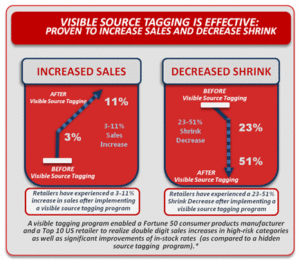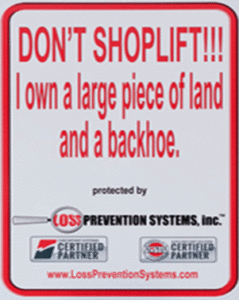 What can make life miserable for a Human Resources or Hiring Manager? In the right circumstances, a Loss Prevention Manager can be the cause of much consternation for a Human Resources Manager. When more than one employee is being apprehended or fired for theft at the same time it requires shifting schedules, moving people around and hiring new people to take the place of the employees being removed. What makes it even more difficult for a retail H.R. Manager is if the employees work in a specialized job function. I confess (with a smile on my face as I write this) that I was responsible more than once for putting a Human Resource Manager in this predicament during my Loss Prevention Manager career. Don’t misunderstand, I was not taking pleasure in the misery of the Human Resource Manager or the Department Manager, for that matter; I was enjoying closing an investigation that netted around five employees in total, three who worked in the one area.
What can make life miserable for a Human Resources or Hiring Manager? In the right circumstances, a Loss Prevention Manager can be the cause of much consternation for a Human Resources Manager. When more than one employee is being apprehended or fired for theft at the same time it requires shifting schedules, moving people around and hiring new people to take the place of the employees being removed. What makes it even more difficult for a retail H.R. Manager is if the employees work in a specialized job function. I confess (with a smile on my face as I write this) that I was responsible more than once for putting a Human Resource Manager in this predicament during my Loss Prevention Manager career. Don’t misunderstand, I was not taking pleasure in the misery of the Human Resource Manager or the Department Manager, for that matter; I was enjoying closing an investigation that netted around five employees in total, three who worked in the one area.
So what was this particular case and why was it funny to me? The case started out as a cash shortage investigation in our food service area. We had multiple departments in our store but the food services employees tended to be more specialized in their duties. Unlike other departments, there were not always employees in the store who could provide what we called back-ups to assist in food/drink preparations. For example, when the front lanes got busy, a call for back-up cashiers would result in employees from all areas of the store responding since everyone was trained as a cashier. The same thing could not be said for our food service area. We simply did not have the same number of trained people who could respond.
As I began developing my case, I conducted live camera surveillances of our food service area. Now a good investigator remains open to the possibility that there is always the chance that one “type” of case can lead to other activity and he/she is prepared to expand an investigation if necessary. Rushing to close a case simply to get a quick statistics is poor investigative technique, but I have seen it happen. It didn’t take long to identify the person I suspected was causing the cash losses, but I also found there was a second person causing shortages. That led me to conduct additional surveillances and watching all transactions that took place. Soon I was noticing drinks and food were being given at reduced prices or for free to other employees and even some customers. The passing of food and under-ringing became so routine it was comical to watch. There were customers I identified as “regulars” coming to the counter to get special deals that weren’t on the menu.
Eventually I identified three food service employees and two or three other store employees regularly getting free meals, in addition to the primary cash theft that instigated the investigation. There were several more employees who received a free drink or two but not on a regular basis. With the prior approval of my District Manager, I involved the Human Resource Manager since it was going to make a significant dent in her ability to staff food services for a little while. Needless to say, she was taken back by the amount of theft and fraud that had been taking place. She was absolutely shocked when it dawned on her that she was about to lose almost a third of her food service staff. To ease her pain a bit I let her know I was not going to go after the employees who received one or two free drinks. With her assistance, we would issue written warnings to those employees.
Because we had a good relationship, our H.R. Manager worked with me to schedule the employees at staggered times during the day so I could conduct individual interviews without one person having time to alert anyone else to what was happening. The day came when I conducted all interviews and a couple of people were prosecuted for cash theft and three or four were terminated for theft of food and policy violations. A couple of employees received final warnings for policy violations but were allowed to continue their employment with the company.
Coverage for the food service area was difficult for a few weeks, but we made it happen. I also had to chuckle because some of our “regular” customers stopped coming for food. A final word of advice to those in LP and management; build strong partnerships with each other, it is mutually beneficial for you and the store.




 a good example using one of the newer clear, Checkpoint Systems stock labels. The trademarked “lock” and wording has been tested extensively.
a good example using one of the newer clear, Checkpoint Systems stock labels. The trademarked “lock” and wording has been tested extensively.

 How do I approach a shoplifting incident? This question is asked of me almost on a daily basis by store managers and owners. We always give advice and best practices on how to deter a shoplifter by using EAS devices, but what should you actually do if you are faced with a shoplifting incident that you personally witness? When should you call the police? When can you legally detain someone? While not every situation is the same, there are some basic best practices to follow. Here’s what I train my managers and can be a great starting point for you.
How do I approach a shoplifting incident? This question is asked of me almost on a daily basis by store managers and owners. We always give advice and best practices on how to deter a shoplifter by using EAS devices, but what should you actually do if you are faced with a shoplifting incident that you personally witness? When should you call the police? When can you legally detain someone? While not every situation is the same, there are some basic best practices to follow. Here’s what I train my managers and can be a great starting point for you.

 ” is well aware of how she is obtaining the merchandise and are even encouraging the actions. These are the types of people that hurt big box retailers and that can put small shops out of business. These are the shoplifters we need to focus on and the ones that the criminal justice system need to come down hard on. The only thing that will stop Jane from stealing is being behind bars. This is her full time job.
” is well aware of how she is obtaining the merchandise and are even encouraging the actions. These are the types of people that hurt big box retailers and that can put small shops out of business. These are the shoplifters we need to focus on and the ones that the criminal justice system need to come down hard on. The only thing that will stop Jane from stealing is being behind bars. This is her full time job.  It’s a normal day at the office. I’m working on a few cases and an email comes across from a manager at one of my stores. There’s not much to it; just says “John” called the store looking for you, here’s his number. Curious to who John is, I immediately give him a call. In my mind I’m thinking it could be a detective, or an Assistant District Attorney maybe.
It’s a normal day at the office. I’m working on a few cases and an email comes across from a manager at one of my stores. There’s not much to it; just says “John” called the store looking for you, here’s his number. Curious to who John is, I immediately give him a call. In my mind I’m thinking it could be a detective, or an Assistant District Attorney maybe.